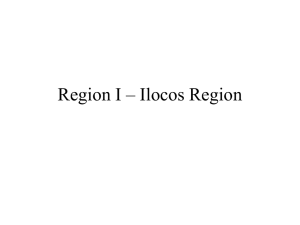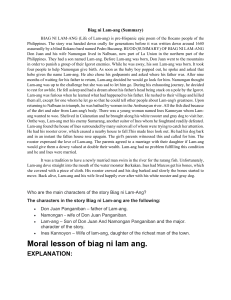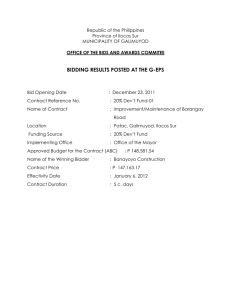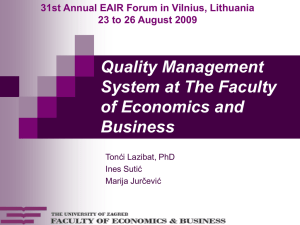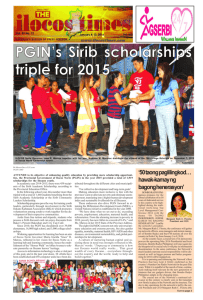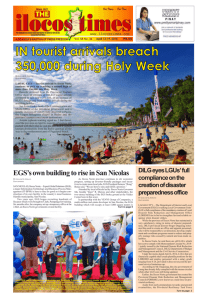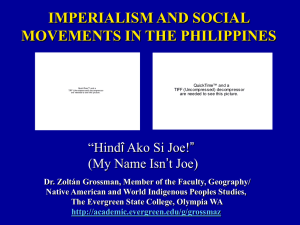Ilocos Region (Region I): Provinces, Culture & Literature
advertisement
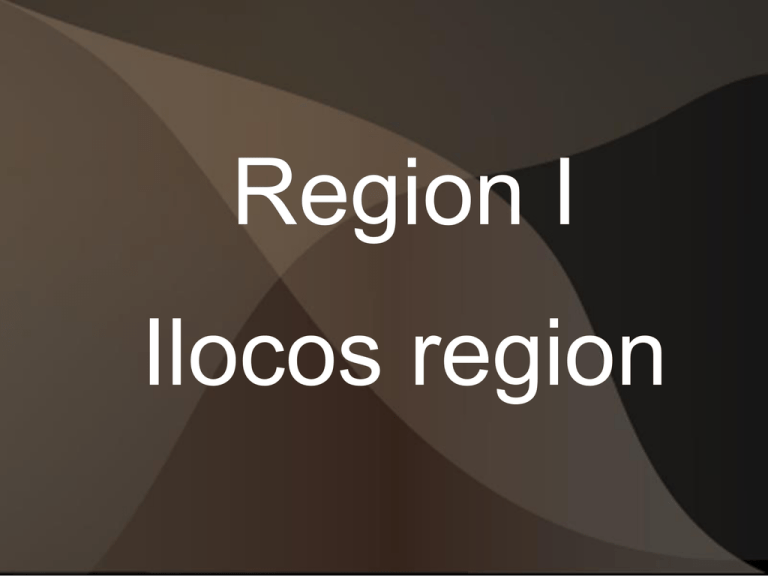
Region I Ilocos region Location It is located in the nortwestern portion of Luzon. It is bounded on the north by the Babuyan Channel, on the south by Central Luzon, on the west by South China Sea and on the east by the Cordillera Mountain Range. Climate The region has a long dry season because of the Cordillera Mountains that block the wind from the Pacific Ocean. It has two distinct seasons: Dry from December to May and wet from June to November. Language Ilocano Pangasinense Tagalog (Filipino) The Ilocos Region has a total land area of 12, 840 2 km . It is composed of four provinces situated along the seacoast. Provinces Ilocos Norte Capital: Laoag City It is situated in Northwest Luzon. It is bounded on the north and west by South China Sea, on the east by Cagayan and Kalinga Apayao, on the southeast by Abra and on the southwest by Ilocos Sur. Landmarks Cape Bojeador Lighthouse Balay Til Ili Paoay Church Home of Juan Luna and Ferdinand Marcos Ilocos Sur Capital: Vigan City It is bounded on the north by Ilocos Norte, on the south by Benguet and La Union, on the west by the South China Sea and on the east by Abra and Mountain Province. Landmarks Pinsal Falls Sulvec Beach in Narvacan Home province of Gabriela Silang, Fr. Jose Burgos and Elpidio Quirino La Union Capital: San Fernando City It is located in the southwestern part of Ilocos Region. It is a hilly province but the western part is a coastal plain and on the east are hills covering a wide portion of the province. It is famous for its white and gray sand beaches and Marcos Bust. Home of Diego Silang Pangasinan Capital: Lingayen It lies on the western coast of Luzon. It is bounded on the north by Lingayen Gulf, La Union and Benguet; on the norteast by Nueva Viscaya; on the east and southeast by Nueva Ecija; on the south by Tarlac and Zambales and on the west by South China Sea. The name of the province literally means “the place where salt is made” Landmarks Hundred Islands in Alaminos Shrine of Nuestra Senora de Manaoag Region I –Literature Pre-colonial Iloko literature were composed of folk songs, riddles, proverbs, lamentations called dungaw, and epic stories in written or oral form. Ancient Ilokano poets expressed themselves in folk and war songs as well as the dallot, an improvised, versified and at times impromptu long poem delivered in a sing-song manner. Iloko Poetry in Spanish Era The earliest known written Iloko poems were the romances translated from Spanish by Francisco Lopez, an Augustinian friar who, in 1621, published his own Iloko translation of the Doctrina Cristiana by Cardinal Bellarmine, the first book to be printed in Iloko. A study of Iloko poetry could be found in the Gramatica Ilokana, published in 1895, based on Lopez's Arte de la Lengua Iloca, earlier published in 1627, but was probably written before 1606. Pedro Bukaneg Father of Ilokano Poetry and Literature Pedro Bukaneg was said to have been thrown by his parents down the Abra River while still an infant because he was blind. A woman who found him gave him away to an Augustinian priest. He was christened Pedro Bukaneg. He was cared for, and sent to school until he became proficient in Spanish and Samtoy (Ilokano dialect). Summary of Biag ni Lam-ang Don Juan and his wife Namongan lived in Nalbuan, now part of La Union in the northern part of the Philippines. They had a son named Lam-ang. Before Lam-ang was born, Don Juan went to the mountains in order to punish a group of their Igorot enemies. While he was away, his son Lam-ang was born. It took four people to help Namongan give birth. As soon as the baby boy popped out, he spoke and asked that he be given the name Lam-ang. He also chose his godparents and asked where his father was. After nine months of waiting for his father to return, Lam-ang decided he would go look for him. Namongan thought Lam-ang was up to the challenge but she was sad to let him go. During his exhausting journey, he decided to rest for awhile. He fell asleep and had a dream about his father's head being stuck on a pole by the Igorot. Lam-ang was furious when he learned what had happened to his father. He rushed to their village and killed them all, except for one whom he let go so that he could tell other people about Lam-ang's greatness. Upon returning to Nalbuan in triumph, he was bathed by women in the Amburayan river. All the fish died because of the dirt and odor from Lamang's body. There was a young woman named Ines Kannoyan whom Lam-ang wanted to woo. She lived in Calanutian and he brought along his white rooster and gray dog to visit her. On the way, Lam-ang met his enemy Sumarang, another suitor of Ines whom he fought and readily defeated. Lam-ang found the house of Ines surrounded by many suitors all of whom were trying to catch her attention. He had his rooster crow, which caused a nearby house to fall. This made Ines look out. He had his dog bark and in an instant the fallen house rose up again. The girl's parents witnessed this and called for him. The rooster expressed the love of Lam-ang. The parents agreed to a marriage with their daughter if Lam-ang would give them a dowry valued at double their wealth. Lam-ang had no problem fulfilling this condition and he and Ines were married. It was a tradition to have a newly married man swim in the river for the rarang fish. Unfortunately, Lam-ang dove straight into the mouth of the water monster Berkakan. Ines had Marcos get his bones, which she covered with a piece of cloth. His rooster crowed and his dog barked and slowly the bones started to move. Back alive, Lam-ang and his wife lived happily ever after with his white rooster and gray dog. Leona Florentino National Poetess of the Philippines Born to a wealthy and prominent family in Vigan, Ilocos Sur, Florentino began to write her first verses in Ilocano at a young age. Despite her potential, she was not allowed to receive a university education because of her gender. Florentino was instead tutored by her mother, and then a series of private teachers. An educated Ilocano priest taught her advanced Spanish and encouraged her to develop her voice in poetry. Due to the feminist nature of her writings, Florentino was shunned by her husband and son, and so was forced to live alone in exile and separately from her family. Florentino married a politician named Elias de los Reyes at the age of 14, and they had five children, including Isabelo de los Reyes, who would later become a Filipino writer, activist and senator. She died at the age of 35. Her poems appear to the modern reader as being too syrupy for comfort, too sentimental to the point of mawkishness, and utterly devoid of form. Moro-moro and Zarzuela in the th 19 century What is Moro-moro? Like the Cenaculo, the Moro-moro is presented also on a special stage. This is performed during town fiestas to entertain the people and to remind them of their Christian religion. What is Zarzuela? It is a musical comedy or melodrama in three acts which dealt with man's passions and emotions like love, hate, revenge, cruelty or some social or political problems. Folk Songs *dallot - versified exchange of wit between a man and a woman *badeng - love song *dung-aw - the death chant Manang Biday Manang Biday is a popular Ilocano folk song which is all about courtship. The lyrics illustrate the courtship of a guy to a lady who happens to be older than the former. The lyrics mostly decribe the lady’s reaction to the courtship. MANANG BIDAY Manang Biday, ilukatmo man ‘Ta bintana ikalumbabam Ta kitaem ‘toy kinayawan Ay, matayakon no dinak kaasian Siasinnoka nga aglabaslabas Ditoy hardinko pagay-ayamak Ammom ngarud a balasangak Sabong ti lirio, di pay nagukrad Denggem, ading, ta bilinenka Ta inkanto ‘diay sadi daya Agalakanto’t bunga’t mangga Lulukisen ken adu a kita No nangato, dika sukdalen No nababa, dimo gaw-aten No naregreg, dika piduten Ngem labaslabasamto met laeng Daytoy paniok no maregregko Ti makapidut isublinanto Ta nagmarka iti naganko Nabordaan pay ti sinanpuso Alaem dayta kutsilio Ta abriem ‘toy barukongko Tapno maipapasmo ti guram Kaniak ken sentimiento
